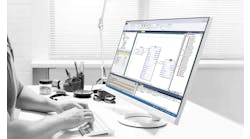It seems inevitable that the amount of innovative technology in machine and factory automation will continue to escalate out of necessity. “We are going to need more automation as our planet’s demographics give us more people to take care of and fewer people to do the work," says John Kowal, director, business development at B&R Industrial Automation.
The automation will move from the low-hanging-fruit types of applications to those more difficult to automate. And it sounds like that will change the face of automation. "We will need to be more efficient and automate tasks that aren’t cost-effective to automate today," says Kowal. "Therefore, the automation tools are going to have to become more sophisticated, so that they can be deployed with less engineering skill at the application level."
From coding shortcuts to factory retrofits, the face and the function of automation will continue to change in the future. "We are going to see less original code in a project and more configuration of powerful, pre-tested control software modules," he says. "Ordering a product online will need to generate a work order, a recipe and an automated batch-size-of-one production process that ships directly to the customer. Today, the emphasis on manufacturing IIoT is on brownfield performance optimization. The future will be greenfield and green patch—new IIoT-enabled systems within existing facilities, applications that can deliver order-of-magnitude productivity improvements."
Better automation controlling more difficult machines and process will be easier to use. "To the user, automation is going to finally become intuitive, just like the automation technology in automobiles that allow a driver or rider in an autonomous vehicle to operate with no special skills," says Kowal. "This means look for autonomous machines in the future."
Some of these innovations are driving B&R's own product development. "Our mapp (modular application) technology continues to expand machine builders’ ability to program less and configure more," says Kowal.
“And our track technology enables an adaptive machine, giving it the capacity to changeover on the fly or reconfigure with different production modules on the same machine platform."
Safe automation, in particular safe motion and safe robotics, are changing the way machines are being built and operated. "Instead of stopping a machine or line, the systems go into safe mode and continue to operate," says Kowal. “This functionality has been embraced by European industry and by a few visionary North American machine builders so far."
The new adaptive technology is beyond the test phase. B&R’s partnerships with machine builders and OEMs are essential to test, validate and apply new technologies, says Kowal. “We are under nondisclosure agreements with dozens of customers on various adaptive-machine projects and conduct applications development in secure facilities,” he explains. “We will only be able to publicly discuss these adaptive machines when the OEMs launch their products."
There is technology, hardware and software out there to make automation products better, faster and easier to use. "We continue to follow Moore’s Law, with scalable solutions from ARM and Atom processors up to the latest Intel Core and Xeon processors," says Kowal. "To ensure interoperability and maintainability, we build our platforms on standards such as HTML5, IEC 61131-3 and TR88.00.02, the most exciting being our commitment to develop the OPC-UA TSN (time-sensitive network) standard for a true deterministic Industrial Ethernet standard."
B&R has offered integration with simulation technology for years. However, considering the Industrial Internet of Things' need for digital twins and the flexibility of track systems, simulation technology is becoming an integral part of its automation solution. I hope other automation suppliers follow suit. Many of the robot manufacturers have useful simulation capabilities; the machine automation suppliers should follow suit.
B&R is innovating advanced solutions. They have servo drives that learn and constantly adjust to mechanical anomalies. Another advancement is anti-slosh technology for smooth and fast handling of open containers of liquids or powders. Another is I/O slices with onboard intelligence to achieve 1-microsecond response time.
The software can combine all of the advanced solutions together. "Software is the key to our ability to integrate technologies to achieve new levels of machine performance and flexibility in one software development environment," says Kowal. "It runs in a single application program on a single processor over the same network. One controller and software environment includes control and visualization of robots, track systems, machine modules, networked safety, IIoT edge devices and process optimization."
These enabling technologies are changing how machines, cells and lines operate. "For example, I’ve recently heard manufacturers wanting to make collaborative robots mobile, to move around the plant where needed," says Kowal. "This could take the form of an AGV-mounted robot arm; these already exist. Combined with track technology, think how an assembly line could be reconfigured efficiently on a daily basis."
Rather than mechanically fixturing these modules, what if positioning could be virtual, enabled by onboard laser or LiDAR (light detection and ranging) sensors to reposition a module to adjust its work envelope to handle different size products, says Kowal. "The next step would be for the mobile modules to become autonomous, using their LiDAR to navigate the plant and go where they are needed next," he says. "It’s possible today; advanced technology will make it practical."






